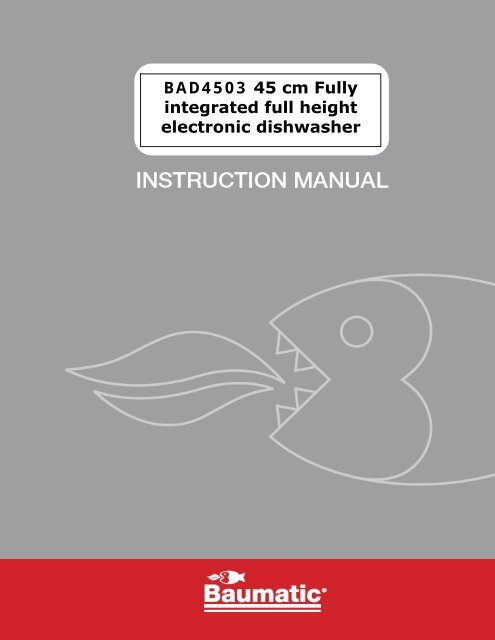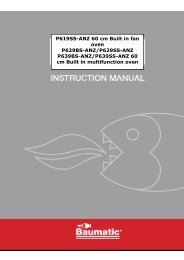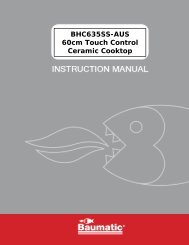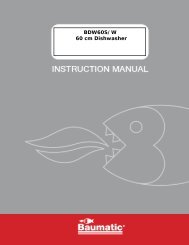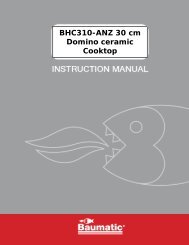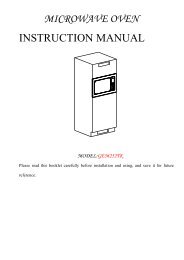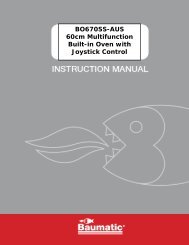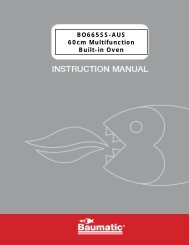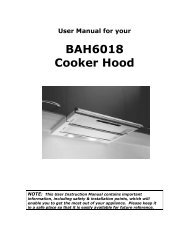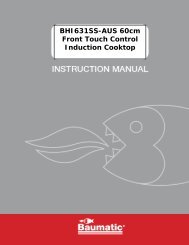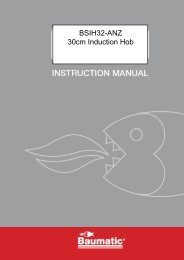BAD4503 45 cm Fully integrated full height electronic ... - Baumatic
BAD4503 45 cm Fully integrated full height electronic ... - Baumatic
BAD4503 45 cm Fully integrated full height electronic ... - Baumatic
Create successful ePaper yourself
Turn your PDF publications into a flip-book with our unique Google optimized e-Paper software.
<strong>BAD<strong>45</strong>03</strong> <strong>45</strong> <strong>cm</strong> <strong>Fully</strong><br />
<strong>integrated</strong> <strong>full</strong> <strong>height</strong><br />
<strong>electronic</strong> dishwasher
Dear Customer,<br />
Congratulations on purchasing your new product from Think Appliances.<br />
We have taken the time to ensure that your appliance is of the highest possible standard<br />
and will give you years of use in your home.<br />
To register your parts and labour warranty (some conditions apply please refer to your<br />
warranty card for more details) please contact out Customer Care team on:<br />
1800 444 357<br />
Our Customer Care centre is there to ensure you get the most out of your appliance. For<br />
example, should you want to learn more about recommended cooking temperatures, the<br />
various cooking functions available, how to set and program your LED clock, and importantly<br />
taking care of your appliance when cleaning, please call us because we are here to help you.<br />
It is important that you read through the following use and care manual thoroughly to<br />
familiarize yourself with the installation and operation requirements of your appliance to<br />
ensure optimum performance.<br />
We also carry a complete range of spare parts for all Think products. For all your spare parts<br />
enquiries please contact our team at Pronto Parts on:<br />
1300 306 973<br />
Again, thank you for choosing an appliance brought to you by Think Appliances and we look<br />
forward to being of service to you.<br />
Kind regards<br />
Management<br />
Think Appliances
USER MANUAL FOR YOUR BAUMATIC<br />
<strong>BAD<strong>45</strong>03</strong> <strong>45</strong> <strong>cm</strong> <strong>Fully</strong><br />
<strong>integrated</strong> <strong>full</strong> <strong>height</strong> <strong>electronic</strong><br />
dishwasher<br />
NOTE: This User Instruction Manual contains important<br />
information, including safety & installation points, which will<br />
enable you to get the most out of your appliance. Please keep it<br />
in a safe place so that it is easily available for future reference; for<br />
you or any person not familiar with the operation of the appliance.<br />
2<br />
DD 27/10/10
Contents<br />
Environmental note 4<br />
Important safety information 5 – 7<br />
Specifications 8 - 9<br />
Description of the appliance 9 - 10<br />
Using your dishwasher 10 - 23<br />
Before first use 10<br />
Filling with dishwasher salt 11 – 12<br />
Setting the water softener level 12<br />
Filling with rinse aid 13<br />
Setting the rinse aid level 13 - 14<br />
Filling with dishwasher detergent 14<br />
Loading the upper basket 15<br />
Adjusting the upper basket 15 - 17<br />
Loading the lower basket 17<br />
The cutlery basket 18 - 19<br />
Loading dishes and cutlery 19<br />
Program table 20<br />
Setting a wash program 21<br />
Changing a wash program 21 - 22<br />
At the end of a wash program 22<br />
Setting a delay start 22<br />
Rinse aid and salt indicator neons 23<br />
Cleaning and maintenance 23 - 26<br />
The filter system 23 - 24<br />
Cleaning the filters 24<br />
Cleaning the spray arms 25<br />
Cleaning the control panel 25<br />
Cleaning the door 26<br />
Error code failure system 26 – 28<br />
General troubleshooting 28 – 30<br />
Installation 30 - 39<br />
Aperture requirements 30 - 31<br />
Preparing and connecting the furniture door 31 – 32<br />
Adjusting the tension of the door spring 33<br />
Connecting to the mains water supply 34<br />
Connecting to the water outlet 35<br />
Connecting to the power supply 35 - 36<br />
Applying the condensation strip 36 - 37<br />
Positioning the dishwasher 37<br />
Levelling the appliance 38<br />
Securing the dishwasher 39<br />
Before first use 39 - 40<br />
Contact details 41<br />
3
ENVIRONMENTAL NOTE<br />
Note: Before discarding an old appliance, switch off and<br />
disconnect it from the power supply. Cut off and render any plug<br />
useless. Cut the cable off directly behind the appliance to prevent<br />
misuse. This should be undertaken by a competent person. Disable<br />
the door lock to make sure that children cannot get stuck inside<br />
the appliance.<br />
4<br />
o The packaging materials that <strong>Baumatic</strong> uses are environmentally<br />
friendly and can be recycled.<br />
o Please discard all packaging material with due regard for the<br />
environment.
IMPORTANT SAFETY INFORMATION<br />
Your safety is of the utmost importance to <strong>Baumatic</strong>.<br />
Please make sure that you read this instruction booklet<br />
before attempting to install or use the appliance. If you<br />
are unsure of any of the information contained in this<br />
booklet, please contact the <strong>Baumatic</strong> Advice Line.<br />
General Safety<br />
o Repairs to your appliance must only be carried out by a<br />
<strong>Baumatic</strong> engineer or one of its authorised service agents. Any<br />
attempt by an inexperienced person to repair the appliance,<br />
could result in injury or damage to your dishwasher.<br />
o If you notice that the mains cable is damaged. The appliance<br />
must not be used. The same applies if you notice that the<br />
worktop, control panel or base area is damaged. As this could<br />
allow access to the internal components of the machine.<br />
o The appliance should be turned off and isolated from the mains<br />
supply, before either cleaning or maintenance work is attempted.<br />
o The mains cable must not be used to pull the plug out of the<br />
electrical socket.<br />
o The machine should not be sprayed with water.<br />
o The external surface of the appliance may become hot whilst<br />
your dishwasher is in use.<br />
o It is possible for small animals to chew either mains cables or<br />
water hoses, which could cause an electric shock hazard.<br />
Installation<br />
o The installation instructions contained within this user manual<br />
should be followed.<br />
o It is obligatory for the completed installation to comply with all<br />
relevant building regulations and local water authority<br />
requirements.<br />
o Before the first use of the appliance, you should follow the<br />
steps listed in the “Before first use” section on page 10<br />
and page 39 of this manual.<br />
5
o Care should be taken not to trap the power supply cable<br />
underneath the appliance whilst installing it.<br />
o No attempt should be made to alter or modify the specifications<br />
of this appliance.<br />
In daily use<br />
o This appliance is only designed to wash normal domestic<br />
washloads. If you use your dishwasher in any other way or it is<br />
incorrectly used, then <strong>Baumatic</strong> accepts no liability for any<br />
damage that might be caused and any guarantee will be void.<br />
o It is recommended that the appliance is unplugged and the<br />
water supply is turned off after the machine is used.<br />
o The detergents, rinse aid and salt that you place in this appliance<br />
should be suitable for automatic dishwashers. With regards to<br />
dosage levels, the detergent manufacturer’s recommendations<br />
should be followed.<br />
o Sharp knifes or ones with long blades are a potential safety<br />
hazard when placed in an upright position in the cutlery basket.<br />
We would recommend that these items are placed horizontally in<br />
the upper basket.<br />
o You should not wash any items that have come into contact<br />
with corrosive, acidic or alkaline chemicals, paint, petrol, iron or<br />
steel debris.<br />
o You should not open the door whilst the appliance is set on a<br />
wash program. Depending on which stage that the wash<br />
program is at, hot water could escape the machine.<br />
o You should not leave the door of the appliance open, unless<br />
you are loading or unloading the dishwasher.<br />
o You should not stand or sit on the door when it is open.<br />
6
Child Safety<br />
o Your dishwasher should only be used by adults. You should not<br />
allow children in the area of the machine unsupervised. You<br />
should not let them touch the controls or play with the appliance.<br />
o It could be possible for a child or pet to gain access to the<br />
dishwasher if the door is left open. Therefore please check the<br />
inside of the appliance before setting it on a wash cycle.<br />
o Any packaging that is removed from the machine should be kept<br />
away from children.<br />
o All detergents should be kept out of children’s reach in a safe<br />
place.<br />
o Some water will remain inside the dishwasher when it has<br />
completed a wash cycle. This water is not suitable for drinking<br />
and may contain residues from the detergents that are used in<br />
the appliance.<br />
Declaration of conformity<br />
This appliance complies with the following European Directives:<br />
-73/23 dated 19/02/1973 Low Voltage Directive and subsequent<br />
modifications.<br />
-89/336 dated 03/05/1989 Electromagnetic Compatibility Directive and<br />
subsequent modifications.<br />
For future reference please record the following information which can<br />
be found on the rating plate and the date of purchase which can be<br />
found on your sales invoice. The rating plate of your dishwasher is<br />
located on the right hand side of the drop down door.<br />
Model Number<br />
Serial Number<br />
……………………………….<br />
……………………………….<br />
Date of Purchase ……………………………….<br />
7
Specifications<br />
Product dimensions<br />
Height:<br />
Width:<br />
Depth:<br />
820 - 850 mm<br />
4<strong>45</strong> mm<br />
570 mm<br />
Aperture dimensions<br />
Height:<br />
Width:<br />
Depth:<br />
820 mm (min)<br />
<strong>45</strong>0 mm<br />
570 mm (min)<br />
Product specifications<br />
o 8 Place settings<br />
o 7 functions:<br />
Normal<br />
Intensive<br />
Economy<br />
Rinse<br />
Rapid<br />
Glass<br />
Soak<br />
o 4 Wash temperatures: 40°C, 50°C, 60°C, 65°C<br />
o 4 Rinse temperatures: 55°C, 65°C, 70°C<br />
o Delay timer<br />
o LED display<br />
o Self-cleaning stainless steel micro-filter<br />
o Anti-leak device<br />
o Anti-flood device<br />
o Height adjustable upper basket<br />
o Collapsible plate racks<br />
o Adjustable feet<br />
o Residual drying<br />
o Concealed heating element<br />
Energy efficiency details<br />
Energy efficiency class: B<br />
Washing performance class: B<br />
Drying performance class: B<br />
8
Electrical details<br />
Rated voltage:<br />
Supply connection:<br />
230 Vac 50 Hz<br />
13 A (double pole switched fused outlet with<br />
3 mm contact gap)<br />
Optional extra<br />
o DWD<strong>45</strong>0SS- Stainless steel door with mark resistant coating<br />
Description of the appliance<br />
1) Upper basket<br />
2) Spray arms<br />
3) Lower basket<br />
4) Water softener<br />
5) Main filter<br />
6) Detergent dispenser<br />
7) Cup shelf<br />
8) Cutlery basket<br />
9) Coarse filter<br />
10) Rinse aid dispenser<br />
11) Drain pipe connector<br />
12) Inlet pipe connector<br />
9
Control panel<br />
1) Program indicator neons<br />
2) Program selection button<br />
3) Rinse aid and salt indicator neons<br />
4) LED display<br />
5) Delay start button<br />
6) ON/OFF indicator neon<br />
7) ON/OFF button<br />
Using your dishwasher<br />
Before first use<br />
o Install the appliance as per the installation instructions contained<br />
within this booklet.<br />
o Fill the water softener with 1 litre of tap water and then fill with<br />
specialist dishwasher salt. After this you should set the water<br />
softener level.<br />
o Fill the rinse aid dispenser and then set the rinse aid dosage.<br />
10
Filling with dishwasher salt<br />
IMPORTANT: You should only use salt that is specially<br />
designed for use in a dishwasher. If any other type of salt is<br />
used in the appliance (in particular table salt), it will damage<br />
the water softener.<br />
o Ideally you should fill the water softener with salt, just before<br />
you are about to run a wash program. This will help to clear any<br />
salt that may have overflowed from the water softener during<br />
the salt filling process.<br />
o Open the door of the dishwasher and then remove the lower<br />
basket. The basket should be empty when you remove it.<br />
o Turn the water softener cap<br />
anticlockwise and remove it.<br />
o Pour 1 litre of water into the water<br />
softener.<br />
IMPORTANT: It is only necessary to do this when you fill<br />
the container with salt for the first time.<br />
o Pour salt into the water softener, using<br />
the funnel that is supplied with the<br />
appliance. You should add<br />
approximately 1.2 kg of salt into the<br />
water softener.<br />
o It is perfectly normal for a small amount of water to come out of<br />
the water softener, whilst you are filling it with salt. This does<br />
not mean that the water softener is filled with the correct<br />
amount of salt.<br />
o Refit and <strong>full</strong>y tighten the water softener cap.<br />
o The salt required warning light will go out approximately 2-6<br />
hours after you have filled the water softener with salt. When<br />
the salt indicator neon lights on the control panel, then you<br />
should follow the filling with dishwasher salt procedure again.<br />
11
o IMPORTANT: You do not need to pour 1 litre of water into<br />
the container when you subsequently fill the water<br />
softener with salt.<br />
Setting the water softener level<br />
It is possible to regulate the amount of salt that the water softener will<br />
release during a wash cycle. The water softener should be set to a<br />
level that is appropriate for the hardness of your water (please refer to<br />
the table below).<br />
To alter the amount of salt that is released by the water softener, you<br />
should:-<br />
o Remove the lower basket and unscrew the cap from the water<br />
softener.<br />
o Locate the ring with an arrow on it that is located<br />
on the water softener. (See figure opposite).<br />
o When you first receive your appliance, the arrow<br />
will be pointing to the minus symbol. Using the<br />
water hardness chart, you should turn the arrow<br />
to the setting that is appropriate for your water<br />
hardness.<br />
o The “middle” selector position is halfway between the minus and<br />
plus symbols.<br />
o IMPORTANT: If you are using 3 in 1 dishwasher tablets and live<br />
in a medium or hard water area, then you should still fill the<br />
water softener with salt. The water softener arrow should be<br />
turned to the minus setting.<br />
12
Filling with rinse aid<br />
The rinse aid is released during the final rinse and it helps<br />
to prevent water from forming droplets on your dishes.<br />
These droplets will lead to spots and streaks being left on<br />
items after the wash program has completed.<br />
o Your dishwasher is designed to utilise liquid rinse aid.<br />
o The rinse aid dispenser is located inside the drop down door,<br />
next to the detergent dispenser.<br />
o To access the rinse aid dispenser,<br />
you should turn the cap anticlockwise<br />
and it will pop out of the hole. Then<br />
slowly pour in liquid rinse aid, the<br />
rinse aid dispenser will hold<br />
approximately 140 ml of rinse aid.<br />
o You should continue to fill with rinse aid, until the level indicator<br />
turns completely black.<br />
o Be careful not to overfill the dispenser, as this could cause<br />
oversudsing when a wash program is selected. Wipe away any<br />
rinse aid excess or spillages with a damp cloth.<br />
o Replace the cap and turn it clockwise until it locks into position.<br />
o You should refill the rinse aid dispenser when the rinse aid<br />
indicator neon lights on the control panel.<br />
o IMPORTANT: If you are using 3 in 1 dishwasher tablets then<br />
you should still fill the rinse aid dispenser.<br />
Setting the rinse aid level<br />
The amount of rinse aid that the dishwasher requires also depends on<br />
the hardness of your water. You should experiment with the rinse aid<br />
setting, until you find a level that gives the best results.<br />
13<br />
o On the first wash cycle, we would recommend<br />
that the rinse aid level is set to number 2.<br />
o If you get water spots and poor drying<br />
performance, then you should turn the arrow<br />
anticlockwise and increase the setting to the next<br />
number.
o You should continue to adjust the rinse aid level upwards until<br />
you get no water spots.<br />
o If you get cloudiness or streaking on your dishes, the rinse aid<br />
level is set too high and it is causing foaming during the wash<br />
cycle. Turn the arrow clockwise and lower the setting to the next<br />
number.<br />
Filling with dishwasher detergent<br />
The detergent dispenser must be refilled at the start of each wash<br />
cycle (apart from the Rinse wash program).<br />
o Open the lid that closes over the detergent dispenser and place<br />
the detergent inside of the dispenser.<br />
o The section marked 1 in the diagram is for the main wash cycle<br />
detergent. Only one detergent tablet should be placed in the<br />
dispenser at any one time. If you are using detergent powder or<br />
liquid, you should follow the detergent manufacturer’s<br />
recommendations.<br />
o The section marked 2 in the diagram can have separate<br />
detergent placed in it for any wash cycle that has a pre-wash<br />
element to it, however this is optional. This must be a liquid or<br />
powder detergent, not another detergent tablet.<br />
o Shut the detergent dispenser lid and position the clip on the<br />
outer edge, so that it holds the lid shut.<br />
o At the beginning of a wash cycle the clip will open and the<br />
tablet/powder/liquid will enter the dishwasher.<br />
14
Loading the upper basket<br />
The upper basket is most suited to washing delicate and light<br />
dishware, such as glasses, coffee & tea cups, saucers, plates, bowls<br />
and shallow pans (that are not heavily soiled).<br />
1. Cups<br />
2. Small serving bowl<br />
3. Large serving bowl<br />
4. Glasses<br />
5. Saucers<br />
6. Dishes<br />
o You should position the dishes and cookware in such a way that<br />
they are not moved by the spray of water during the wash cycle.<br />
o Use the diagram above as a guide to the most appropriate way<br />
to load the upper basket.<br />
Adjusting the upper basket<br />
Your dishwasher has an adjustable upper basket which you can alter to<br />
the most suitable position for the items you are going to wash in the<br />
upper basket.<br />
o The <strong>height</strong> of the upper basket can be adjusted by removing the<br />
upper basket from the guide supports.<br />
o IMPORTANT: The upper basket must be empty when you are<br />
removing it from the guide supports.<br />
15
Lower position<br />
o If the upper wheels are placed in the<br />
guide supports, then the basket is in<br />
the lower position.<br />
o For accommodating additional tumblers, cups and mugs. You can<br />
also place small, espresso sized cups on top of the side racks.<br />
You should take care to ensure that there is enough clearance<br />
between the top of the cups placed on top of the side racks and<br />
the underneath of the dishwasher interior.<br />
IMPORTANT: Care should be taken when placing long<br />
stemmed glassware, such as champagne glasses in the<br />
upper basket. If they are not positioned correctly, then<br />
there is a risk that they may topple over when the upper<br />
basket is pushed in or pulled out.<br />
Upper position<br />
o If the lower wheels are placed in<br />
the guide supports, then the basket<br />
is in the upper position.<br />
o For accommodating items such as glass tumblers and wine<br />
glasses. Wine glasses should be placed upside down, so that the<br />
stem of the glass rests in one of the grooves on the side flap.<br />
o Please note that when the basket is in the upper position, you<br />
cannot have the side flaps in a raised position. Otherwise the<br />
basket will not slide back into the interior of the dishwasher.<br />
With upper<br />
basket raised<br />
With upper<br />
basket lowered<br />
Maximum <strong>height</strong> of<br />
dishes (upper basket)<br />
Maximum <strong>height</strong> of<br />
dishes (lower basket)<br />
19 <strong>cm</strong> 30 <strong>cm</strong><br />
24 <strong>cm</strong> 25 <strong>cm</strong><br />
16
IMPORTANT: Care should be taken to make sure that the spray<br />
arms can move freely when items have been loaded into the<br />
baskets.<br />
Loading the lower basket<br />
The lower basket is most suited to washing larger and more heavily<br />
soiled items, such as saucepans, saucepan lids and serving dishes. You<br />
can also load bowls and a variety of plates into the lower basket.<br />
1. Serving plate<br />
2. Dessert dishes<br />
3. Side plates<br />
4. Dinner plates<br />
5. Cutlery basket<br />
o Saucepans and serving bowls must always be placed with their<br />
bases upwards.<br />
o Deep saucepans should be slanted, to allow water to run off.<br />
o The bottom rack has prongs at the rear of the basket that can be<br />
folded downwards, to allow for easier loading of larger<br />
saucepans and serving bowls.<br />
17
The cutlery basket<br />
Cutlery should be placed inside of the cutlery basket. The cutlery<br />
basket should then be placed in the appropriate position in the lower<br />
basket.<br />
1. Forks<br />
2. Soup spoons<br />
3. Dessert spoons<br />
4. Teaspoons<br />
5. Knives<br />
6. Serving spoon<br />
7. Gravy ladle<br />
8. Serving fork<br />
o For the best washing performance,<br />
cutlery should be placed through<br />
the slots in the top of the cutlery<br />
basket.<br />
IMPORTANT: Do not allow items of cutlery to fall through<br />
the bottom of the cutlery basket, as this may cause<br />
damage to the spray arm and/or the cutlery. If the bottom<br />
of the basket begins to deteriorate and allows items to fall<br />
through, you should replace the cutlery basket.<br />
Loading dishes and cutlery<br />
Household cloths, sponges or any other object that<br />
may absorb water SHOULD NOT be washed in a<br />
dishwasher.<br />
o Remove leftovers and soften the remnants of burnt food in pans,<br />
prior to loading dishes in the appliance.<br />
o Once the dishwasher has been loaded, check that the spray arms<br />
can move freely. If the spray arm comes into contact with any<br />
item, then you should rearrange the wash load.<br />
o Cups, glasses, pans etc should all be loaded with their bases<br />
upwards, so that water does not collect inside of them.<br />
o Cutlery and dishes should not cover each other; otherwise you<br />
may get poor wash results.<br />
18
o Do not allow glasses to touch inside the dishwasher, otherwise<br />
damage may occur.<br />
o Small objects can be placed inside of the cutlery basket.<br />
The following items are NOT suitable for washing<br />
inside a dishwasher:-<br />
o Cutlery with a handle of mother-of-pearl, wood, horn or china.<br />
o Plastic items that are not resistant to heat.<br />
o Cutlery that consists of glued parts that are not resistant to heat.<br />
o Cutlery items or crockery that are bonded.<br />
o Copper or pewter items.<br />
o Lead crystal glass.<br />
o Wooden platters.<br />
o Synthetic fibre items.<br />
The following items are not always suitable for<br />
washing inside a dishwasher:-<br />
o Stoneware should only be washed if the manufacturer of the<br />
item has marked it as dishwasher safe.<br />
o Plastic items (such as lunchboxes) should only be washed if the<br />
manufacturer has marked it as dishwasher safe.<br />
o Glazed crockery may fade with repeated washing inside of a<br />
dishwasher.<br />
o Items made of silverware or aluminium can discolour when<br />
washed inside a dishwasher.<br />
o Any food residue should be removed from silver items<br />
immediately, as this can also result in discolouration.<br />
o Certain types of glass may become dull or cloudy after a large<br />
number of washes.<br />
19
Program table<br />
Program Cycle Program<br />
information<br />
Normal<br />
For normally<br />
**<br />
soiled loads,<br />
such as pots,<br />
plates, glasses<br />
and lightly soiled<br />
pans, standard<br />
daily cycle.<br />
Intensive<br />
For the heaviest<br />
soiled loads,<br />
such as pots,<br />
pans, casserole<br />
dishes and<br />
dishes that have<br />
been sitting with<br />
dried food on<br />
them for awhile.<br />
Economy<br />
For lightly soiled<br />
loads, such as<br />
plates, glasses,<br />
bowls and lightly<br />
soiled plates.<br />
Rinse<br />
For dishes that<br />
need to be rinsed<br />
and dried only.<br />
Description<br />
of cycle<br />
Pre-rinse<br />
Pre-rinse<br />
Wash (50°C)<br />
Rinse<br />
Rinse (65°C)<br />
Drying<br />
Pre-rinse<br />
Pre-rinse<br />
(50°C)<br />
Wash (60°C)<br />
Rinse<br />
Rinse (70°C)<br />
Drying<br />
Pre-rinse<br />
Wash (50°C)<br />
Rinse<br />
Rinse (65°C)<br />
Drying<br />
Rinse<br />
Rinse (65°C)<br />
Drying<br />
Detergent<br />
pre/main<br />
5 grams<br />
(pre-rinse)<br />
22 grams<br />
(main wash)<br />
5 grams<br />
(pre-rinse)<br />
22 grams<br />
(main wash)<br />
22 grams<br />
(main wash)<br />
Program<br />
times*<br />
117<br />
Minutes<br />
(1:57<br />
hours on<br />
display)<br />
127<br />
Minutes<br />
(2:07<br />
hours on<br />
display)<br />
102<br />
Minutes<br />
(1:42<br />
hours on<br />
display)<br />
50<br />
minutes<br />
Glass<br />
Rapid<br />
Soak<br />
For lightly soiled<br />
loads, such as<br />
glasses, crystal<br />
and fine china.<br />
A shorter wash<br />
for lightly soiled<br />
loads that do not<br />
need drying.<br />
To rinse dishes<br />
that you plan to<br />
wash later that<br />
day.<br />
Pre-rinse<br />
Wash (40°C)<br />
Rinse<br />
Rinse (65°C)<br />
Wash (40°C)<br />
Rinse<br />
Rinse (55°C)<br />
15 grams<br />
(main wash)<br />
15 grams<br />
(main wash)<br />
70<br />
Minutes<br />
(1:10<br />
hours on<br />
display)<br />
<strong>45</strong><br />
minutes<br />
Pre-rinse 7<br />
minutes<br />
* The wash program times that are quoted are intended as a guide<br />
only. Please note that factors external to the machine, e.g. the<br />
temperature of your water supply, your water pressure etc. can affect<br />
the time it takes for the wash program to complete.<br />
** Normal is the testing program for EN 50242.<br />
20
Setting a wash program<br />
Make sure that the before first use section has been<br />
followed.<br />
o Check whether the appliance needs rinse aid or salt adding to it.<br />
o Pull out the top and bottom baskets, then load them in<br />
accordance with the loading instructions.<br />
o Push the top and bottom baskets <strong>full</strong>y back into position.<br />
o Add detergent<br />
o Turn the appliance on by using the ON/OFF button.<br />
o IMPORTANT: Wait for 5 seconds before pressing the<br />
program selection button, otherwise the appliance may<br />
not function correctly.<br />
o Press the program selection button to choose an appropriate<br />
wash program for the load that you are washing. The relevant<br />
program indicator neon will light to show which program you<br />
have selected.<br />
o Select any program options that you want to use (e.g. delay<br />
start).<br />
o Close the door firmly, so that you hear the door lock click shut.<br />
o After a few seconds, you will hear the appliance begin to fill with<br />
water and the wash program will have started.<br />
Changing the wash program<br />
IMPORTANT: This should only be attempted when the cycle has<br />
only just started, otherwise the detergent tablet may have<br />
already released or you could have hot water escaping.<br />
o Slightly open the door of the appliance and turn off the power<br />
using the ON/OFF button.<br />
o Wait for a minute before <strong>full</strong>y opening the door of the appliance.<br />
o Turn the appliance on by using the ON/OFF button and wait for 5<br />
seconds before pressing the program selection button.<br />
21
o Press and hold down the program selection button for 3 seconds<br />
to cancel the wash program. Then use the program selection<br />
button to choose the correct wash program.<br />
o Select any program options that you want to use (e.g. delay<br />
start).<br />
o Close the door firmly, so that you hear the door lock click shut.<br />
o After a few seconds, you will hear the appliance begin to fill with<br />
water and the wash program will have started.<br />
At the end of a wash program<br />
o The time display will flash for 8 seconds and a buzzer will sound.<br />
o If you have used the delay start mode, the time display will flash<br />
for 8 seconds but the buzzer will not sound.<br />
o Open the door of the appliance.<br />
o Use the ON/OFF button to switch the dishwasher off and unload<br />
the dishwasher.<br />
Setting a delay start<br />
It is possible to delay the start of the wash program for up to a<br />
maximum of 24 hours.<br />
o Check whether the appliance needs rinse aid or salt adding to it.<br />
o Pull out the top and bottom baskets, then load them in<br />
accordance with the loading instructions.<br />
o Push the top and bottom baskets <strong>full</strong>y back into position.<br />
o Add detergent<br />
o Turn the appliance on by using the ON/OFF button.<br />
o IMPORTANT: Wait for 5 seconds before pressing the<br />
program selection button, otherwise the appliance may<br />
not function correctly.<br />
o Press the program selection button to choose an appropriate<br />
wash program for the load that you are washing. The relevant<br />
program indicator neon will light to show which program you<br />
have selected.<br />
22
o Press the delay start button and you will see the amount of time<br />
that you are delaying the wash program by, appear in the LED<br />
display.<br />
o Close the door firmly, so that you hear the door lock click shut.<br />
o Once the period of time that you set has passed, the dishwasher<br />
will start the wash program that you selected.<br />
Rinse aid and salt indicator neons<br />
o The rinse aid and salt indicator neons on the<br />
control panel will let you know when the<br />
appliance needs rinse aid or salt adding to it.<br />
o The neon indicates that you need to add rinse aid to the<br />
appliance. You should follow the procedure outlined on page 13.<br />
o The neon indicates that you need to add dishwasher salt to<br />
the appliance. You should follow the procedure outlined on page<br />
11.<br />
Cleaning and maintenance<br />
IMPORTANT: The appliance should be disconnected<br />
from your mains supply before commencing any<br />
cleaning process.<br />
The filter system<br />
Your appliance is fitted with three levels of filtering; these are located<br />
in the base of the dishwasher for ease of access.<br />
1) Main filter<br />
2) Coarse filter<br />
3) Fine filter<br />
23
Main filter-<br />
Coarse filter-<br />
Fine filter-<br />
Food and soil particles are trapped by this filter and<br />
pulverised by a special jet on the lower spray arm.<br />
This debris is then washed down the drain.<br />
Larger items such as pieces of bone or glass, which<br />
could clog the drain, are trapped in this filter.<br />
This filter holds soil and food residue in the sump<br />
area and prevents it from being redeposited on the<br />
dishes during a wash cycle.<br />
IMPORTANT: Whilst the filtering system is efficient, your<br />
dishwasher is not a waste disposal unit. All items being<br />
washed inside of the dishwasher should have food scraps<br />
removed from them before being loaded into the appliance.<br />
Cleaning the filters<br />
For best performance and results, the entire filter assembly should be<br />
thoroughly cleaned regularly (ideally after each wash cycle).<br />
1. Turn the coarse filter<br />
anti-clockwise and then<br />
lift it upwards. Rinse out<br />
this section under a tap<br />
to remove any food<br />
debris that remains in it.<br />
2. Pull out the main filter<br />
and rinse this under the<br />
tap to remove any food<br />
debris that is trapped in<br />
it.<br />
3. Pull out the fine filter and<br />
rinse this under the tap<br />
to remove any food<br />
debris that is trapped in<br />
it.<br />
24<br />
4. Place the fine filter back in its original position.
5. Place the main and coarse filter back into their original positions<br />
in the base of the dishwasher. You must turn the coarse filter<br />
clockwise to lock it back into position.<br />
IMPORTANT: If a glass gets smashed inside of the appliance,<br />
you must check there is no glass in the filter before the<br />
machine is used again as this can cause a drainage failure.<br />
IMPORTANT: THE DISHWASHER SHOULD NEVER BE<br />
SET ON A WASH CYCLE WITHOUT THE FILTERS BEING<br />
INSIDE OF THE APPLIANCE.<br />
Cleaning the spray arms<br />
The spray arms should be cleaned regularly, to prevent hard water<br />
deposits from clogging the spray arm jets and bearings.<br />
o To remove the spray arm, unscrew the nut and take out the<br />
washer that sits on top of the spray arm.<br />
o Gently pull upwards to remove the spray arm.<br />
o Wash the spray arm in warm, soapy water and use a soft brush<br />
to clean the jets.<br />
o Rinse the spray arm thoroughly and then reassemble the spray<br />
arm back in its original position.<br />
Cleaning the control panel<br />
IMPORTANT: Do not use any abrasive cleaner or household polish on<br />
either the control panel or operating parts.<br />
25
o Wipe over the control panel using a brand new damp cloth with<br />
warm water.<br />
Cleaning the door<br />
o To clean the edge around the outside of the door, you should use<br />
a soft, damp cloth only.<br />
o To prevent water from penetrating the door lock or electrical<br />
components, DO NOT use a spray cleaner of any kind.<br />
o DO NOT use any abrasive cleaner or scouring pads on the inner<br />
or outer surfaces, as they may cause damage to them.<br />
Error code failure system<br />
If your appliance senses that it is not operating correctly, then an error<br />
code may appear in the display window.<br />
The following error codes can possibly be remedied by the customer<br />
and the steps outlined below should be followed.<br />
BEFORE COMPLETING ANY MAINTAINEANCE ON THE<br />
APPLIANCE, IT SHOULD BE DISCONNECTED FROM YOUR MAINS<br />
POWER SUPPLY.<br />
E1<br />
o Longer than expected fill time.<br />
Check the water pressure of your mains water supply.<br />
Clean the mesh filter that sits in the inlet hose.<br />
Ensure that the inlet hose is not kinked or crushed.<br />
Make sure the water tap that the machine is connected to is turned<br />
on <strong>full</strong>y.<br />
E2<br />
o Longer or extended drain time.<br />
The drain pipe may be placed in too high a position or incorrectly.<br />
Check the installation instructions and ensure that the installation is<br />
correct.<br />
Check that the outlet hose is not kinked or crushed.<br />
Make sure that the drain hose has not extended beyond its original<br />
length.<br />
26
E3<br />
o Longer heating time- not reaching the required temperature.<br />
Malfunction of the temperature sensor or heating element.<br />
Call the <strong>Baumatic</strong> Customer Care Department.<br />
E4<br />
o The machine has sensed water in the base.<br />
Check that the outlet hose is not kinked or crushed.<br />
Check that there are no blockages in the drain hose or the drainage<br />
system that the appliance is connected to.<br />
The drain pipe may be placed in too high a position or incorrectly.<br />
Check the installation instructions and ensure that the installation is<br />
correct.<br />
E5<br />
o Switch cannot shut off automatically- program not finishing its<br />
cycle.<br />
Low voltage or power switch failure.<br />
Call the <strong>Baumatic</strong> Customer Care Department.<br />
E6<br />
o Open circuit<br />
Thermistor<br />
Call the <strong>Baumatic</strong> Customer Care Department.<br />
E7<br />
o Short circuit<br />
Thermistor<br />
Call the <strong>Baumatic</strong> Customer Care Department.<br />
o Once you have taken action to rectify the problem that has<br />
caused the fault code to appear, plug the machine back into your<br />
mains power supply.<br />
o Turn the machine on using the ON/OFF button and wait for 5<br />
seconds.<br />
o Press and hold down the delay start button and the ON/OFF<br />
button, until the appliance switches off.<br />
o Wait for 5 seconds, and then switch back on the appliance using<br />
the ON/OFF button.<br />
o Wait for a further 5 seconds before attempting to set a wash<br />
program, using the program selection button.<br />
27
IMPORTANT: If any other fault code appears in the<br />
display window, you should not attempt to clear it yourself<br />
and contact the Customer Care Department.<br />
IF THE FAULT CODE REAPPEARS AFTER FOLLOWING<br />
THE ABOVE ADVICE AND CLEARING THE FAULT<br />
CODE. YOU SHOULD TURN OFF THE APPLIANCE;<br />
DISCONNECT THE APPLIANCE FROM YOUR MAINS<br />
SUPPLY. THEN ARRANGE FOR AN ENGINEER TO<br />
ATTEND THE APPLIANCE. YOU SHOULD CONTACT<br />
THE CUSTOMER CARE DEPARTMENT ON TELEPHONE<br />
NUMBER (0118) 933 6911.<br />
IF AN ENGINEER ATTENDS DURING THE GUARANTEE<br />
PERIOD AND FINDS THAT A FAULT HAS BEEN<br />
CAUSED BY AN ITEM ON THE ERROR CODE LIST,<br />
WHICH COULD HAVE BEEN CLEARED BY THE<br />
CUSTOMER. THEN YOU MAY BE LIABLE FOR THE<br />
COST OF THE SERVICE CALL.<br />
General troubleshooting<br />
PROBLEM<br />
Dishwasher<br />
doesn’t<br />
run<br />
Drain pump<br />
doesn’t stop<br />
Noise<br />
POSSIBLE<br />
CAUSES<br />
Fuse blown or the<br />
circuit breaker has<br />
tripped<br />
Power supply is not<br />
switched on<br />
Water pressure is<br />
low<br />
Overflow<br />
Some audible sounds<br />
are normal<br />
WHAT TO DO<br />
Replace the fuse or reset the circuit<br />
breaker. Remove any other<br />
appliances that are sharing the same<br />
circuit with the dishwasher.<br />
Make sure that the dishwasher is<br />
turned on and that the door is closed<br />
securely.<br />
Make sure that the power cord is<br />
<strong>full</strong>y plugged into the wall socket.<br />
Check that the water supply is<br />
connected properly and that the<br />
water is turned on.<br />
The system is designed to detect an<br />
overflow. If it does, then it will run<br />
the drain pump continuously when<br />
there is power to the appliance.<br />
You will get a level of operating noise<br />
during a wash cycle, in particular<br />
when food is being removed from<br />
items and when the detergent<br />
dispenser places the tablet into the<br />
tub.<br />
28
Utensils are not<br />
secure in the baskets<br />
or something small<br />
has dropped into the<br />
basket<br />
Ensure that everything is loaded as<br />
per <strong>Baumatic</strong>’s loading instructions.<br />
Suds in the<br />
tub<br />
Stained tub<br />
interior<br />
Dishes are not<br />
<strong>full</strong>y dried<br />
Motor hums<br />
Improper detergent<br />
use<br />
Spilled rinse aid<br />
Detergent with<br />
colourant was used<br />
Rinse aid dispenser is<br />
empty<br />
If the dishwasher is not going to be<br />
used for a period of time, then you<br />
should make sure that the appliance<br />
is set on a wash program once a<br />
week. Otherwise the seal around the<br />
motor may dry out and cause noise.<br />
Ensure if you are using 3 in 1<br />
detergent tablets, in conjunction with<br />
rinse aid and salt that the levels are<br />
set correctly.<br />
Always wipe up any excess rinse aid<br />
or rinse aid spillages immediately.<br />
Use a detergent without colourant.<br />
Make sure that the rinse aid<br />
dispenser is filled with rinse aid.<br />
Dishes and<br />
pans are not<br />
clean<br />
Improper program<br />
Improper loading<br />
Select a more intense wash program.<br />
Make sure that the spray arms and<br />
the detergent dispenser are not<br />
being impeded by large dishes.<br />
Spots and<br />
filming on<br />
glasses and<br />
pans<br />
Extremely hard water<br />
Low inlet<br />
temperature<br />
Improper loading<br />
Improper detergent<br />
Incorrect salt/rinse<br />
aid levels<br />
Refer to the relevant sections of this<br />
booklet, to ensure that the<br />
detergent, salt and rinse aid levels<br />
are set correctly. Ensure that the<br />
appliance is loaded correctly.<br />
Steam<br />
Black or grey<br />
marks on<br />
dishes<br />
Water<br />
standing in<br />
the bottom of<br />
the tub<br />
29<br />
A normal<br />
phenomenon<br />
Aluminium utensils<br />
have rubbed against<br />
dishes<br />
This is normal<br />
You may get a small amount of<br />
steam coming through the vent by<br />
the door latch, during drying and<br />
water draining.<br />
Use a mild abrasive cleaner to<br />
eliminate the marks. Make sure that<br />
the appliance is loaded correctly in<br />
future.<br />
A small amount of clean water in the<br />
base of the appliance is not<br />
something to be concerned about.
Dishwasher<br />
leaks<br />
The rinse aid<br />
dispenser is<br />
overfilled or rinse aid<br />
has been spilt inside<br />
the appliance<br />
Take care not to overfill the rinse aid<br />
dispenser. Spilt rinse aid could cause<br />
oversudsing and lead to overflowing.<br />
Wipe away any spills immediately<br />
with a damp cloth.<br />
Dishwasher isn’t<br />
level<br />
Make sure that the dishwasher is<br />
level.<br />
Installation<br />
IMPORTANT: THIS INSTALLATION MUST BE<br />
COMPLETED BY A SUITABLY QUALIFIED PERSON.<br />
BAUMATIC ONLY SANCTION THE INSTALLATION<br />
GIVEN IN THIS INSTRUCTION MANUAL. YOU<br />
SHOULD DISPOSE OF ALL PACKAGING IN AN<br />
ENVIRONMENTALLY FRIENDLY MANNER.<br />
Aperture requirements<br />
30
o The aperture that your dishwasher needs to be installed into<br />
should resemble the one shown in the drawing on page 30.<br />
o There should be less than a 5 mm gap between the top of the<br />
dishwasher and the underneath of the worktop.<br />
Installation stages<br />
1. Preparing and connecting the furniture door.<br />
2. Adjusting the tension of the door spring.<br />
3. Connecting to the mains water supply<br />
4. Connecting to the water outlet<br />
5. Connecting to the power supply<br />
6. Applying the condensation strip<br />
7. Positioning the dishwasher<br />
8. Levelling the dishwasher<br />
9. Securing the dishwasher<br />
Preparing and connecting the furniture door<br />
o IMPORTANT: The furniture door is not supplied with the<br />
appliance. You should purchase one to match with the rest of<br />
your kitchen cabinets.<br />
31
o The maximum weight of the furniture door should be 5.5<br />
kilograms. The maximum thickness of the furniture door<br />
should be 15 mm.<br />
o Use the installation template supplied with the appliance to mark<br />
up and then drill out the necessary holes in the furniture door.<br />
o Attach the<br />
upper hooks<br />
onto the<br />
furniture<br />
door.<br />
o Attach the<br />
lower hooks<br />
onto the<br />
furniture<br />
door.<br />
o Lift the furniture door towards the dishwasher door, ensuring<br />
that the upper and lower hooks locate into the slots on the<br />
outside of the dishwasher door.<br />
o Push the furniture door downwards so it locks into place on the<br />
dishwasher door.<br />
o Open the dishwasher<br />
door and find the<br />
covers that are<br />
located on either<br />
side of the outer<br />
edge.<br />
o <strong>Fully</strong> tighten the<br />
screws into the<br />
holes. Make sure<br />
that you screw them<br />
tightly into the<br />
furniture door.<br />
o Replace the covers.<br />
32
Adjusting the tension of the door spring<br />
o The door of the dishwasher is<br />
attached to springs. These<br />
are set at the factory to<br />
ensure that they are at the<br />
proper tension, so that the<br />
door can open and close<br />
smoothly.<br />
o After the furniture door has been fitted, you will need to adjust<br />
the tension of the door spring.<br />
o Using an Allen key, rotate the adjusting screw to either tighten<br />
or slacken the steel cable.<br />
o The doors’ spring tension is correct when:-<br />
a) The door remains horizontal when in the <strong>full</strong>y opened<br />
position.<br />
b) You are able to shut the door easily, by raising the door using<br />
your fingers.<br />
o WARNING: If you do not adjust the tension of the door spring,<br />
then it could cause damage to the appliance.<br />
33
Connecting to the mains water supply<br />
IMPORTANT: Do not connect the appliance to your mains<br />
water supply using an old or an existing water inlet hose.<br />
The inlet hose supplied with the dishwasher is the ONLY one<br />
that should be used.<br />
DO NOT CONNECT THE WATER INLET HOSE TO A HOT<br />
WATER TAP.<br />
o The inlet hose will be located inside the cabinet of the dishwasher.<br />
o Connect the water inlet hose (C) to a threaded water tap (A) that<br />
has a 3/4” thread and to the inlet hose connector on the appliance.<br />
o <strong>Fully</strong> tighten the inlet hose to the water tap and the dishwasher.<br />
34
Connecting to the water outlet<br />
Secure the drain hose, so that it cannot move whilst the<br />
dishwasher is in use.<br />
Place the end of the drain hose on your drain pipe. Push it a<br />
short way down into your drain pipe.<br />
IMPORTANT: Do not insert the drain hose too deeply into the<br />
pipe, as this may cause siphoning.<br />
NEVER EXTEND THE DRAINAGE HOSE FROM ITS ORIGINAL<br />
LENGTH.<br />
Connecting to the power supply<br />
IMPORTANT: The electrical socket must still be accessible<br />
once the appliance is installed.<br />
35
Consult the rating plate, located on the right hand side of the<br />
drop down door BEFORE making the electrical connections.<br />
Ensure that the voltage reaching the plug is the same as that on<br />
the rating plate.<br />
DO NOT REMOVE THE RATING PLATE AS THE<br />
INFORMATION ON IT IS IMPORTANT.<br />
The moulded plug that is supplied with the appliance must be<br />
placed into an earthed and insulated socket.<br />
Broken or damaged power leads must only be replaced by a<br />
suitably qualified person. A power lead of a similar type must be<br />
used in replacement.<br />
Power lead type – H 0 V V – F 3G 1,5.<br />
IMPORTANT: We do not recommend that this appliance is<br />
connected to an extension lead.<br />
Applying the condensation strip<br />
36<br />
o The condensation strip must be fitted to the underside of the<br />
worktop to protect it against the ingress of moisture. The strip<br />
will deflect steam that rises from your appliance, away from the<br />
underneath of the worktop.
o The condensation strip will be located inside of your dishwasher.<br />
o Ensure that the underneath of the worktop is clean before<br />
sticking the strip to it.<br />
o Separate the backing paper away from the strip.<br />
o Stick the condensation strip to the underneath of the worktop.<br />
o IMPORTANT: Failure to attach the condensation strip could<br />
result in damage to your worktop.<br />
Positioning the dishwasher<br />
o Place the feet of the dishwasher into the slide rails.<br />
o Care<strong>full</strong>y slide the dishwasher back into position, underneath the<br />
worktop.<br />
37
Levelling the appliance<br />
o IMPORTANT: Your dishwasher must be level for it to operate<br />
properly.<br />
o Make sure that the dishwasher is supported whilst it<br />
is being levelled, otherwise it may tip over.<br />
o The rear feet can be<br />
adjusted by using the<br />
adjusting screw at the<br />
front of the appliance.<br />
o The front feet can be<br />
adjusted using a<br />
spanner.<br />
o Use a spirit level to check that the<br />
appliance is level.<br />
o Check that the appliance is level from<br />
side to side.<br />
o Check that the appliance is level from<br />
front to back.<br />
38
Securing the dishwasher<br />
o The dishwasher must be secured to the worktop, this can be<br />
done in one of two ways:-<br />
Before first use<br />
o Standard worktop- Secure the dishwasher to the<br />
underside of the worktop by using two wood screws.<br />
o You should screw through the holes in the brackets at the<br />
top of the dishwasher cabinet.<br />
o These screws should be <strong>full</strong>y tightened.<br />
o Marble/granite worktop- The material of the worktop<br />
will mean that it is impossible to put a screw through the<br />
underneath of the worktop.<br />
o On either side of the front edge of the dishwasher cabinet,<br />
there is a rubber stopper. You should remove the rubber<br />
stoppers, to reveal a pre-drilled hole on either side of the<br />
dishwasher.<br />
o Secure the dishwasher to the cupboard either side of it, by<br />
screwing a wood screw through the pre-drilled holes into<br />
the cupboards. These screws should be <strong>full</strong>y tightened.<br />
o The rubber stoppers should then be refitted into their<br />
original position.<br />
You should check the following before using the appliance for the first<br />
time:-<br />
o That the dishwasher is level and fixed in position.<br />
o That the water tap is <strong>full</strong>y open.<br />
o That there are no leaks at either end of the drain or inlet hoses.<br />
o That the inlet and outlet hose are <strong>full</strong>y tightened.<br />
o That the inlet and outlet hoses are not kinked.<br />
o That the power is switched on.<br />
o That the water softener has been filled with 1 litre of water and<br />
salt.<br />
o That the rinse aid dispenser has been filled.<br />
39


